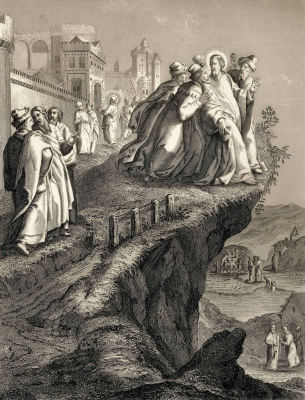Gospel in Art: No prophet is ever accepted in his own country

The attempt to throw Christ off a cliff, by Alexandre Bida, 1853 © Alamy
Source: Christian Art
Gospel of 4 March 2024
Luke 4:24-30
Jesus came to Nazara and spoke to the people in the synagogue: 'I tell you solemnly, no prophet is ever accepted in his own country.
'There were many widows in Israel, I can assure you, in Elijah's day, when heaven remained shut for three years and six months and a great famine raged throughout the land, but Elijah was not sent to any one of these: he was sent to a widow at Zarephath, a Sidonian town. And in the prophet Elisha's time there were many lepers in Israel, but none of these was cured, except the Syrian, Naaman.'
When they heard this everyone in the synagogue was enraged. They sprang to their feet and hustled him out of the town; and they took him up to the brow of the hill their town was built on, intending to throw him down the cliff, but he slipped through the crowd and walked away.
Reflection on the engraving
At the end of this morning's gospel reading, Jesus meets with a very violent reaction from the inhabitants of Nazareth, his home town. The people hustled Jesus out of the town, intending to throw him down the hill on which their town was built. Their reaction to Jesus was one of great anger. They simply did not want to believe anything he said to them. The inhabitants of Nazareth were angry with Jesus because he identified himself with two prophets, Elijah and Elisha, who ministered to people beyond Israel, people whom the inhabitants of Nazareth would have considered unworthy of such attention. The people of Nazareth had a much narrower view of God than Jesus had. Jesus reveals a God who relates to us not on the basis of whether we are worthy or deserving but simply out of a compassionate love, a boundless love.
In our engraving by Alexandre Bida, issued in 1853, we see Jesus depicted three times: once coming out of the city gate, then once at the foot of the hill, being rushed at by the angry crowd, and finally standing at the top of the cliff. In the bottom right he is depicted a fourth time, leaving Mary and his house behind to start his mission: a flashback, so to speak.
Jesus was simply showing the people of Nazareth that the God of Israel was the God of all humanity and that God often sent his prophets to care for people beyond Israel, indeed, to care for those who would have been considered enemies of Israel.
LINKS
Gospel in Art: https://christian.art/
Today's Reflection: https://christian.art/daily-gospel-reading/luke-4-24-30-2024/


















